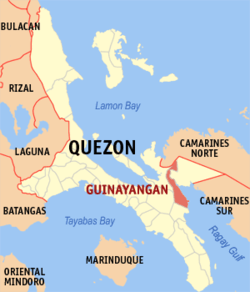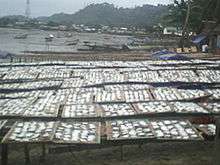Manlayo, Quezon
| Barangay Manlayo, Guinayangan Quezon | |
|---|---|
| Barangay | |
 Map of Quezon showing the location of Guinayangan. | |
| Country |
|
| Region | CALABARZON (Region IV-A) |
| Municipality | Guinayangan Quezon |
| Government | |
| • Type | Barangay |
| • Barangay Captain | Adoracion P. Arieta |
| Time zone | GMT (UTC+8) |
| ZIP code | 4319 |
| Area code(s) | 042 |
| Demonym | Manlayuhin |
| Website | http://angmanlayo.wordpress.com |
Manlayo (/mɑːnˈlaɪ.oʊ/; PSGC: 045618034) is one of the 54 barangays comprising the town of Guinayangan, Quezon. It is the 4th most populated Barangay of its municipality. Situated in one of the shorelines of Ragay Gulf. Manlayo is seated in North East coastal part of Guinayangan, making it a town's gateway for sea food paradise. Origin of the word “Manlayo” is unknown though it is always associated with portmanteau of old Visayan word “man”[1] meaning too and word “layo”[2] means far. Thus origin believed to be “Too far”. Other etymologies are retold to people that during 1927 a story of early Caviteño settlers associating its name from literal Tagalog translation of Marcos Manalo's remote fishing ground[3] though none have ever confirmed the true origin of word. Original settlers believed to be Visayan and Bicolano. During the “The Great Fish Race” of circa:1950-70 new settlers from Cavite and Batangas populated the coastal areas. Early Caviteño settlers, according to records of census, were the clans of Luis Diones, Pastorfide and Esteban Dualan who were natives of Barrio Labac, Naic Cavite

Most people here are self-sufficient. Fishing and other marine products are the major source of income, fish drying and other curing of sea denizens follows second. Beach fronts and foreshores are mostly converted to fish drier/Fish Flake or curing rows/hand flake (Tagalog:bilaran). Mangrove-made barn houses called boat shed (Tagalog: kamalig) were mostly found near the shore use for smoked fish curing and a type of fishmeal processing called fish hydrolysate(Tagalog:dyako). It also became a major business of some natives. Fish meal processing of bycatch contributes extra income to fishermen, where it is sold by heaps or kilograms to fish meal processor(Tagalog:magdyadyako) .

Mid areas of barangay are now reclaimed but coastal edges are constantly shrink by frequent typhoons that visit the region. Declined in catches and the profitability of trawling during the 50s spawned other type of fishing activity - the "Basnig" or Bagnets.[4] During the period 1959-63 “Basnigan” made most number of fishing landings here[5] and had made Ragay Gulf the “Basnig fishing ground” of nearby provinces like Camarines Sur, Sorsogon and Cavite. The advent of two-strokes engine trawlers and Dredge Fishing (i.e. Kuto-kuto, Galadgad and Norway(trawlers) make way to new fishing system during the 80s. Crabs and shrimps fishing (i.e. Bubo, Sakag and Mangingilaw) minimal activity are declining but still use today. Late 90s, Republic Act No.8550, Section 90,The Philippine Fisheries Code of 1998 mandated the ban of active fishing gears in municipal water,[6] it brought downsides to sea dependent cultures of Manlayo. Descendants of old fishing multitude strive to work overseas while some struggle to cities like Lucena and Manila.
Gradually, people are moving to land based work and participate to growing land passenger transportation business in adjacent poblacion of Guinayangan. Today numbers of successful professionals who were fishermen descendants are contend to alter their fate by working abroad and later returning to their roots, building their houses locally and enjoying annual barrio fiesta.
Barangay Data
| Official Name | Barangay Manlayo |
| Other Name | Manlayo |
| Population | 1,592 |
| Code | 045618034 |
| School District | |
| Chairman | Adoracion P. Arieta |
| Diocese | Diocese of Gumaca |
| Patron Saint | Nuestra Señora De La Paz |
| Fiesta | Last Sunday of August |
Geography
Brgy. Manlayo is located at the East side of Brgy. Calimpac and at the North East side of Guinayangan Poblacion. With a total 12 hectares of lot area. Majority of coastal edges are sandy with most marsh land areas are mangrove shores. Almost 30% of land area are salt marsh and inundation is present on some areas during high tide.
People and culture
Population
1,592[7]
Languages
The main languages spoken are Tagalog, Bicolano, Visayan and English. Fishermen are mostly Visayan speaking natives who were migrated during the 60s and 70s fishing race. Tagalog with Caviteños' intonations are noticeable among northern dwellers of barangay.
Fiesta
Every last Sunday of August, Manlayo celebrates its Barrio Fiesta, in honor of Nuestra Señora De La Paz or Our Lady of Peace. The Fluvial and Sea Caracol punctuated the event thus making the main attraction for the yearly event. The fluvial parade usually initiated by official costume competition that marks the colorful gala of display of creativity of its natives. Such event proliferates as annual “must see” to adjacent town of Guinayangan.
Religion
The majority of the population are Roman Catholic, with Iglesia ni Cristo following next. Protestants and Jehovah's Witnesses are lesser account of population. Though other religions are presents like Christian Fellowships, Seventh Day Adventist, Baptists, Methodist and Muslims it only contribute much lesser than Protestants.
Schools
Don Guillermo Eleazar Elementary School (Formerly Manlayo-Kalimpak Elementary School)
References
- ↑ Binisaya-Cebuano To English Dictionary and Thesaurus.,9 April 2010.binisaya.com.
http://www.binisaya.com/node/21?search=binisaya&word=man&Search=Search. - ↑ Binisaya-Cebuano To English Dictionary and Thesaurus.,9 April 2010.binisaya.com. http://www.binisaya.com/node/21?search=binisaya&word=layo&Search=Search.
- ↑ Molines, Alodia Kasaysayan Ng Guinayangan, 4 April 2010,http://peoplesrepublicofguinayangan.blogspot.com/
- ↑ Butcher, J:The Closing of the Frontier:A History of the Marine Fisheries of
Southeast Asia c.1850-2000', page 183.Institute of Southeast Asian Studies(Singapore),2004. - ↑ Butcher, J:The Closing of the Frontier:A History of the Marine Fisheries of
Southeast Asia c.1850-2000, page 182-185.Institute of Southeast Asian Studies(Singapore),2004. - ↑ Republic Act No.8550, Section 90,The Philippine Fisheries Code of 1998
- ↑ 2007 Phils. Census of Population
External links
Official Blog of Manlayo Guinayangan Quezon Ang Tanglaw Ng Manlayo
Official Website of Guinayangan Quezon http://guinayangan.com